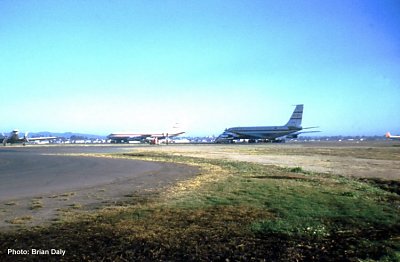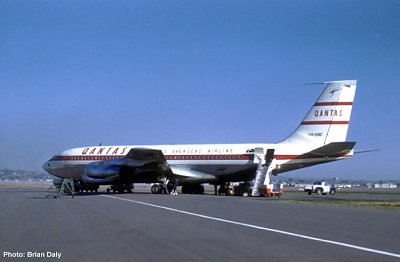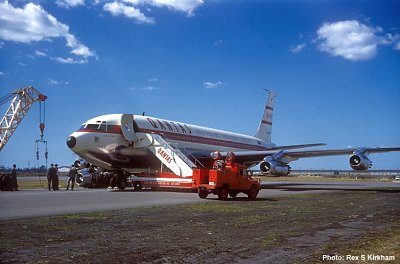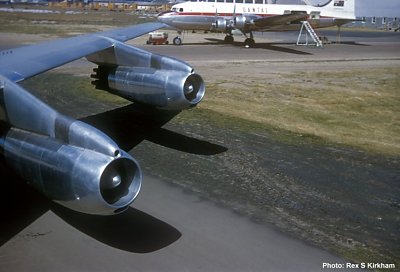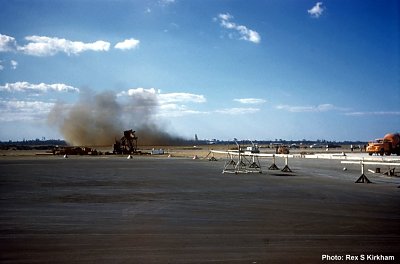|
On Sunday 16
August 1959, Qantas Boeing 707 VH-EBC City of Canberra under
the command of Captain Ian Ralfe and carrying 81 passengers and
13 crew was due to arrive in Sydney from San Francisco (via Honolulu
and Nadi) at 1230 but strong crosswinds in Sydney forced it to divert
to Brisbane where it arrived at 1324 landing on "Brisbane's newly
completed jet strip". The Brisbane Courier-Mail also reported
that "thousands of people flocked to the airport" to see the 707.
It was reported that the aircraft was parked some distance from
the terminal to avoid areas of freshly laid tarmac. Three buses
ferried the passengers and crew to the terminal where they were
cleared by three Customs officers who had been called in for the
diversion. Rex Kirkham from the Qantas city sales office recalls
that the passengers included Qantas General Manager C.O. Turner,
a group of Boeing executives and a party of travel agents. Rex was
tasked with showing the Boeing executives around Brisbane while
they waited for a flight to Sydney. The Courier-Mail also
reported that: "Qantas Queensland Manager (Mr. F. W. Angell) said
all passengers were cleared from Brisbane Airport for Sydney by
domestic airlines by 1930". (Although the crosswinds still prevailed
in Sydney, conditions were not as limiting for prop-jet or piston
domestic aircraft as they were for the 707).
As the last of the passengers from VH-EBC was departing from Brisbane,
another Qantas Boeing 707 VH-EBB City of Sydney flown by
Captain Ron "Torchy" Uren and Captain Max Bamman was preparing to
depart Sydney for San Francisco (via Nadi and Honolulu) on its first
revenue service with 73 passengers and 15 crew. Although the strong
crosswinds still prevailed, this did not prevent VH-EBB from departing
at 1925. However, not long after departure, while 150 miles from
Sydney, number three engine was shut down because of low oil pressure
and VH-EBB turned back to Sydney at 1947. The aircraft circled overhead
Sydney at 29,000 feet burning off fuel while the crew hoped that
the crosswinds would abate. While orbiting Sydney, the passengers
were served dinner. The aircraft had departed Sydney with fuel for
6 hours 33 minutes so there was no urgency to land. It was reported
in the local press that the maximum crosswind for a 707 to land
was 23 knots and the minimum runway length was 6,000 feet. This
meant that only the east-west runway was long enough and it was
all crosswind. Winds averaged 30 mph for hours and one gust at 60
mph was recorded at 2115. (The apparent inadequacies of Sydney Airport
received much attention in the Sydney Morning Herald over
ensuing days). At 2213 the aircraft diverted to Brisbane where it
landed at 2325 to join VH-EBC which had diverted earlier that morning.
Local press reported that the flight from Sydney to Brisbane had
been in the record time of 49 minutes (a 707 had done the trip in
58 minutes on 16 July). For this to be a valid comparison it would
suggest that the strong southerly tailwinds had more than offset
the loss of an engine! The Courier-Mail reported that "the
passengers and crew were taken by bus to Lennons Broadbeach and
the Chevron Hotel, Surfers Paradise, to spend the night. A Qantas
spokesman said that it had been impossible to arrange accommodation
for them in Brisbane because of the Exhibition bookings. He said
the passengers would leave from Brisbane in another Qantas Boeing
707 jet at 2.30 p.m." (on Monday 17 August). (August was then and
is still to this day one of the worst times to be accommodating
disrupted passengers in Brisbane because of the annual Exhibition,
a state fair which draws visitors from all over Queensland). The
press also reported a second flocking of spectators to the airport
but this time it involved "more than 100 people in pyjamas"! Brisbane
resident and aviation enthusiast, Brian Daly, heard of the diversions
on the ABC radio news on Monday morning so he dashed out to the
airport where he found that possession of a camera allowed him to
mingle with a group of press photographers who were being ushered
across the tarmac to photograph the aircraft. Brian's historic colour
photograph of both 707s together on the Brisbane tarmac was later
to become the catalyst for this story.
Although a departure time is not recorded, VH-EBC evidently departed
Brisbane early on the Monday morning for Sydney where it was required
to take up the scheduled service to San Francisco. Although it is
not stated in the Qantas Maintenance Log, it is clear that VH-EBC
must have operated via Brisbane to pick up the passengers from the
previous day's diverted service. The Courier-Mail reported
that the City of Canberra (confirming VH-EBC) departed Brisbane
at 1445 on Monday 17 August for Nadi, Fiji "trailing four clouds
of sooty black smoke" witnessed by an estimated two thousand spectators.
Earlier on Monday 17 August, the Qantas DC-4 VH-EBM Philippine
Trader had departed Sydney at 0545 with a replacement engine
for VH-EBB. The DC-4 arrived back in Sydney with the unserviceable
engine at 2015. The Courier-Mail reported that VH-EBB was
expected to depart for Sydney at 0700 on Tuesday after the engine
change had been completed. As VH-EBB was due to begin several days
of training at Avalon from Tuesday 18 August, it is likely that
the aircraft positioned directly to Avalon from Brisbane.
Although the Qantas Boeing 707-138 was certified to carry a spare
engine in a fifth pod, this was not an option on the day in question.
VH-EBA had been retained by Boeing for certification of the fifth
pod and although VH-EBA was in Australia during the events in question
it is not known if the fifth pod had been approved for airline use.
In any case, it will be seen that fifth pod was not an option because
of aircraft availability. At this time, only four 707s had been
delivered to Australia. Of these, only two were available for service
and both of these had diverted to Brisbane!
VH-EBB was delivered to Sydney on 2 July 1959.
VH-EBC was delivered to Sydney on 9 July 1959.
VH-EBA was delivered to Sydney on 20 July 1959 but it was
undergoing a check in Sydney on 16 August and did not return to
service until 19 August.
VH-EBD was delivered to Sydney on 12 August 1959 but did
not enter service until 14 October having been used for crew training
at Avalon in the interim.
VH-EBE the next 707 to be delivered, did not arrive in Sydney
until 17 September 1959.
The Players:
VH-EBC was sold in March 1967 and was later leased to Canadian Pacific
Airlines in whose service the aircraft crashed at Vancouver in February
1968.
VH-EBB was sold in April 1967 and went on to serve several airlines.
Ultimately, like many of the Qantas 707-138Bs, it was converted
to a VIP aircraft. It served in this role until August 1998 when
it was damaged beyond repair in an arson attack at Port Harcourt,
Nigeria.
The DC-4 VH-EBM was sold in October 1959, just two months after
the events in discussion. While serving as a freighter with Trans
Mediterranean Airlines of Lebanon, the DC-4 crashed into the sea
on take-off from Brindisi in July 1962.
Thanks to:
Colin Lock
Bill Fishwick
Rex Kirkham
Brian Daly
John Burke
Sources:
The Sydney Morning Herald
The Courier-Mail
The Qantas Maintenance and Flying Record Log held by the Qantas
Heritage Collection
|

